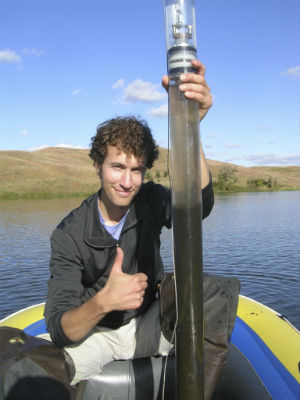This article was originally written by Greg Seitz in 2016 for Field Notes -Stories from the St. Croix Watershed Research Station of the Science Museum of Minnesota; it is used here with permission of the SCWRS.
 Robert Dietz with sediment core used to analyse history of phophorus in lakesImagine a lake full of fish and frogs and waterfowl. Surrounded by fields and forests. Blue sky reflected in the water. Kids swimming in it.
Robert Dietz with sediment core used to analyse history of phophorus in lakesImagine a lake full of fish and frogs and waterfowl. Surrounded by fields and forests. Blue sky reflected in the water. Kids swimming in it.
One summer, the lake starts turning green. Scientists discover too much nutrient-rich runoff is feeding algae blooms, some of which are poisonous to people and animals. The food web is disrupted, the fishing suffers, and nobody wants to put a toe in the water.
So septic systems are upgraded, rain gardens and buffer strips installed, and best management practices put to work on agricultural lands upstream. Runoff slows down and more soil and nutrients stay on the land. Algae has less phosphorus and nitrogen to eat, and noxious blooms shrink.
Right? Not necessarily.
In lakes throughout the upper Midwest, from giant Lake of the Woods to dozens of smaller lakes in our urban and agricultural landscapes, clean water has not obviously followed pollution reductions. It can be a big disappointment.
It doesn’t mean the watershed cleanup has been a waste. If runoff was not reduced now, the lakes would never recover. But the complex connections between land, water, climate, chemistry, algae, and even carp can conspire to make us pay a high price for past sins.
It also makes accurately predicting how long it will take for a lake to improve a very vexing question.
Reincarnated phosphorus
The key factor in such stubborn lakes is whether or not phosphorus that was washed in years or decades ago is caught in a cycle of temporary burial and resurrection. If phosphorus isn’t permanently buried by sediments, or carried away by lake outflow, it can live on a long time.
Phosphorus in water readily enters the food chain, where it is taken up by algae which eventually die and fall to the bottom, releasing the phosphorus as it decomposes. Depending on conditions at the bottom of the lake, the phosphorus is either buried as new sediments accumulate on top, or released back to the lake water.
Doctoral researcher Robert Dietz, working with Dr. Dan Engstrom, the research station’s director, as his advisor, is undertaking an ambitious effort to figure out where phosphorus mobility happens and where it doesn’t – and why. The study could be said to have started more than 20 years ago, when Engstrom collected sediment cores from lakes around the state – and recorded the locations’ GPS coordinates. Now, Dietz has returned to some of those same spots and taken new cores to compare with the old ones to see if the phosphorus deposited in the past was staying put or instead has migrated to near the top, where it can be easily recycled into the lake.
“We were able to quantify the degree of phosphorus mobility in an actual field setting, where most other studies have been based on short-term lab experiments or models,” Dietz said. The evidence this project is collecting will be highly valuable in setting more accurate expectations about how long it could take a lake to recover from nutrient pollution.
It better be useful, because Dietz has dedicated many long days and nights in the laboratory –by his count, more than 900 hours. He napped on a couch or in his car on several occasions. To extract and measure phosphorus from 1,200 sediment samples, Dietz calculates he made more than 8,000 liquid transfers – that’s about 22,000 pipette squeezes.
Metals, depth, and carp
But finally, some patterns are emerging. For one thing, two common metals in the sediments have very different effects. Iron binds to phosphorus, but in a low-oxygen environment like the bottom of a lake, releases it back into the water. In contrast, aluminum also chemically binds to phosphorus, but does not release it when bottom waters become anoxic. The ratios of these materials in the sediments depend on the area’s geology, while oxygen conditions depend on how long a lake stratifies during summer, how much algae is produced at the lake surface, and how rapidly oxygen in bottom waters is depleted as the algae dies, sinks, and decomposes.
These are the conditions that Dietz and Engstrom’s study is seeking to understand. “It’s like we’re working on a big jigsaw puzzle, but the dog ate an important piece. We’re trying to get him to regurgitate it,” Dietz says.
The depth of the lake, and even the fish in it, can also affect how much phosphorus gets reused. Both factors basically determine how much the bottom sediments get disturbed. The bottom of a shallow lake is much more affected by wave and wind action than the sediments in a deep lake. Non-native carp, nosing through the muck of a shallow lake, can also keep it stirred up.
Dietz is in the midst of analyzing his vast real-world data, which will hopefully reveal much more about how phosphorus moves around in the mud. Figuring this out will be what Engstrom calls a “keystone for being able to predict the timeframe of lake recovery.”
Whatever is learned about how long it might take lakes to be free of the effects of excess phosphorus, Engstrom also points out another important lesson: nutrient pollution has long-term consequences. “it’s a lot easier to keep lakes clean in the first place than to fix them after they’re damaged.”
